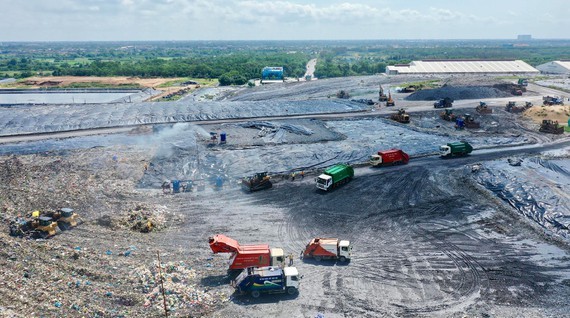
Tang The Cuong, Head of the Climate Change Department under MONRE, shared in the meeting that as many nations are enthusiastically helping Vietnam to cope with negative effects of climate change, the country should determinedly decrease its gas emissions by 251 million tonnes of CO2 in 2030, equal to its total emissions in 2014.
Therefore, the Government has already introduced a necessary legal frame to carry out the three solutions to reduce greenhouse gas emissions, protect the ozone layer, and develop a carbon market in the five fields of energy, agriculture, industrial production activities, waste, land use and forest land use change.
Businesses in these fields are supposed to take gas emissions inventory beginning next year according to the standard set by MONRE in order to actively reduce CO2 release.
Enterprises participating in the meeting voiced their concerns over the complexity of newly established administrative procedures related to this inventory taking.
Chairman of Vietnam Automobile Transportation Association Nguyen Van Quyen stated that there is no need to form a Center for Gas Emission Inspection because there exist other state-owned inspection facilities, which can normally check gas emission of vehicles using the EURO 4-5 Standard for new vehicles. Instead, more attention should be paid to the development of a proper route for old automobiles to reduce greenhouse gas release.
General Secretary of Vietnam Steel Association Dinh Quoc Thai said that gas emission inventory and carbon credit issuing for Vietnamese businesses to participate in the global carbon market are not at all new concepts. With the regulated limit of 3,000 tonnes of CO2 emission per year, most enterprises in the steel industry need to take gas emission inventory, and they are ready for this process.
Many air conditioner manufacturers are worried since all of their products use refrigerants, which are not going to be widely used in Vietnam and other nations in the world. Observing the new regulation, these enterprises have to register for a quota to import these fluids each year, which will significantly affect their yearly production plan.
In the field of waste treatment, several enterprises agreed that besides regulations for gas emissions inventory, there must be transparency and standardization in investment in waste process technologies.
Also, there must be price floor and ceiling for waste treatment using each specific technology and in each local area. This will hopefully boost the investment of the community in the aspect, indirectly leading to reducing greenhouse gas release due to waste burying.
Welcoming the suggestions and concerns of all businesses in the meeting, Mr. Tang The Cuong once again asserted that Vietnam ensures to the world to decrease gas emissions by 9 percent (without international support) or 27 percent (with global help) by 2030. So there is no avoidance in this matter but to adjust the operations and production plans accordingly.
MONRE will continue to collect more recommendations from related individuals and organizations to perfect the draft decree so that it can be formally launched in 2022.
























